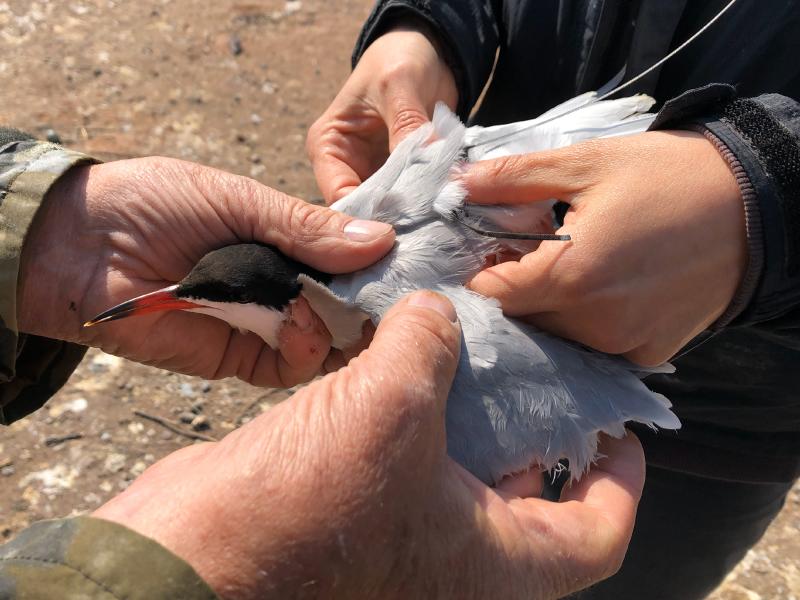Featured Research Labs

Program Overview
Understanding the ecosystem needs of terrestrial and aquatic wildlife to inform conservation efforts, management of natural resources, and opportunities to restore habitat in urban and rural environments.
Recent Research
- Black Spruce forest peatland studies led to development and testing of alternative harvest methods that will help inform sustainable forest management and enhance understanding of these complex habitats and valuable ecosystems that maintain biodiversity.
- Deer-Vehicle Collision Project is informing improved highway safety efforts by the Minnesota Department of Transportation. Additional funding was approved to expand the study to the Twin Cities metro area.
- Moose habitat review is informing a Minnesota Department of Natural Resources effort to establish large areas of moose habitat in northeast Minnesota.
Featured Research Projects
Related News

From the tree tops to boots on the ground, this avian ecologist enjoys his role in informing forest management

More than ‘just the facts,’ researchers lean into ‘acts’ and ‘pacts’ to address challenges of a changing world

Temperatures and habitat changes push species into ‘Zone of Sympatry’ with northern cousins.

NRRI cross-disciplinary research explores availability of food sources for declining species of bug-eating birds.

Renowned Duluth avian ecologist, former NRRI leader, Jerry Niemi, co-authors The Breeding Birds of Minnesota.

NRRI study helps inform benefits of shipping channel dredge material for island habitat.

NRRI scientists present findings on projects with broader water community.

Warm winter weather in northern latitudes can have both positive and negative effects on well-known and beloved resident bird species, like the Canada Jay, Boreal Chickadee and Black-capped Chickad

Wildlife biologist finds NRRI research on the 'wild side' fits her life and passion.

NRRI research underway to understand availability of flying insects impact to bird populations.
Media Coverage
- – Talking deer collisions with U of M – Grand Rapids Herald Review
- – Risk of hitting a deer increases in Minnesota with time change Sunday – WJON radio - St. Cloud
- – Study: fishers migrating, adapting to southeast – Outdoor News Minnesota
- – Minnesota drivers hit thousands of deer a year. Here's where it happens most. – Star Tribune
- – Detailed accounts of 250 birds in Minnesota – Hometown Focus
- – How our extreme weather is impacting fish and wildlife in our region – WDIO
- – Talking Minnesota’s migratory birds with U of M – University of Minnesota News
- – Identifying Deer-Vehicle Collisions in Minnesota – Center for Transportation Studies
- – Birds and climate: it’s a complex relationship – Hometown Focus
- – Canada Lynx research in northeastern Minnesota continues, plans to expand – WTIP
- – Fisher research at NRRI – WDIO
- – Minnesota DNR: Don't veer during peak deer, moose season – WCCO News
- – Minnesota researchers explore how road design can reduce deer collisions – KSTP-TV
- – Talking deer collisions with U of M – University of Minnesota News
- – Birds, bugs and climate change – MPR News
- – Weiss: Old friends return — fisher, bobcat sightings on the rise – Rochester Post Bulletin
- – Connecticut Warbler and other songbird populations on the decline in Superior National Forest – WTIP
- – Fisher population continues to decline across Superior National Forest – WTIP
- – Minnesota researchers aim to reduce deer-vehicle collisions along Highway 61, other roadways – WTIP
- – Study sends fisher biologists back to the drawing board – The Timberjay
- – Northern Minnesota experiment attracted some fishers — and other critters, too – Duluth News Tribune
- – Why deer crossing signs have disappeared from Minnesota highways – Local Today
- – Do you enjoy bird watching? Researchers need your help this summer – KBJR News
- – Damming research: Study finds beavers might not be all bad for trout streams – Duluth News Tribune
- – Minnesota Researchers Will Count Dead Deer to Prevent Future Vehicle Collisions – Field & Stream
- – Minnesota drivers may hit 20 times the deer reported to state – Duluth News Tribune
- – Insect pests continue to threaten trees near Lake Superior, BWCA – WTIP North Shore Community Radio
- – Potential impacts of emerald ash borer on wildlife in black ash wetlands – University of Minnesota Research Brief
- – Study analyzes beavers as 'ecosystem engineers' near North Shore rivers – WTIP North Shore Community Radio
- – Study reveals woodcock wintering grounds – Duluth News Tribune
- – Beaver dams important to freshwater ecosystems – Red Wing Republican Eagle
- – New study demonstrates the value of beavers as ecosystem engineers – TBNewsWatch.com
- – Research finds beavers a critical component of Northland forests – Duluth News Tribune
- – Beavers support freshwater conservation and ecosystem stability – University of Minnesota Research Brief
- – Minnesota researchers to study how climate change affects flying squirrels – Grand Forks Herald
- – Wood turtles declining in Minnesota – Duluth News Tribune
- – Green Visions: "This is a warning signal from our world" – KUMD
- – Trail cams keep tabs on fisher denning boxes – Outdoor News





